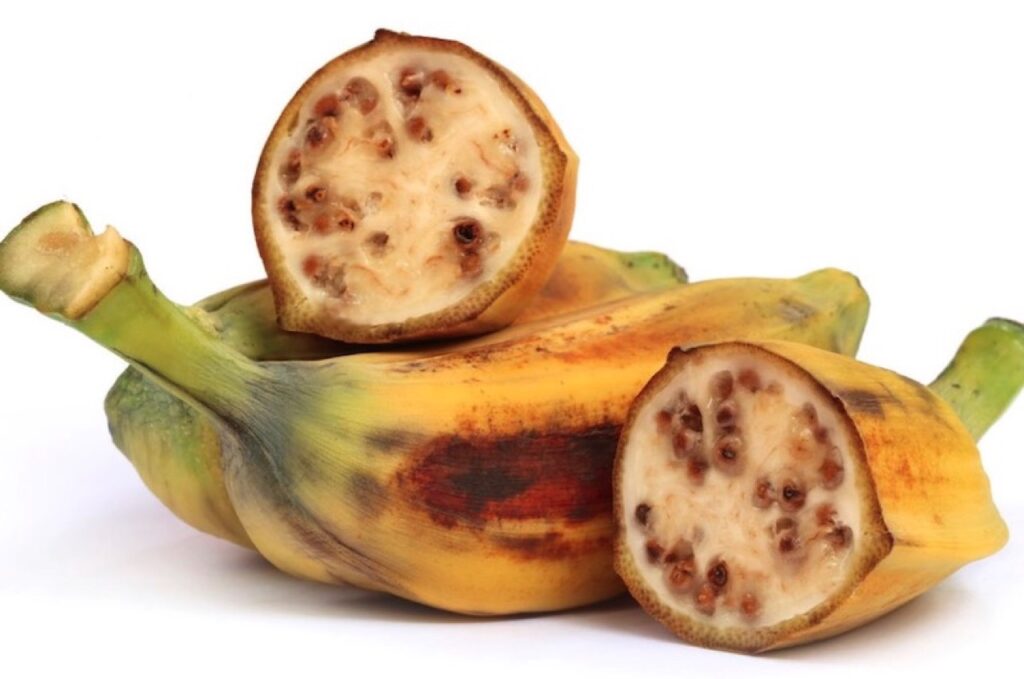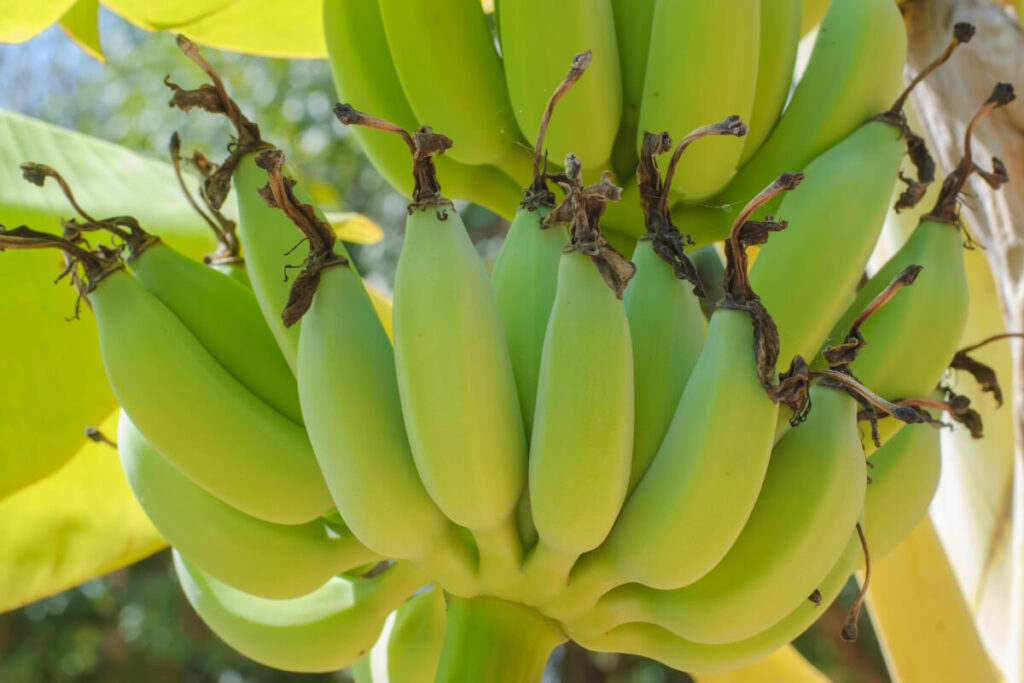The banana is one of the most popular fruits in the world, and it is believed that it was the first fruit on earth. Originating from the jungles of Southeast Asia, bananas are the perfect portable snack, and they even come in their own biodegradable wrapping!
Bananas also have health benefits as they are a great source of fiber and nutrients like potassium, vitamin B6, vitamin C, and various antioxidants. They can even be used to pep-up your houseplants.
When you eat a banana, wipe the inside of the banana peel over the leaves of your houseplants. Not only will that remove the build-up of dust, it will also give your plants a nutritious hit of potassium.
- Related Article: How Long Does It Take a Banana Peel to Decompose?
With its benefits and uses, many people wonder if they can grow bananas from seed. Let’s discuss banana varieties and the growing process of banana trees from seeds.
Do Bananas Have Seeds?
Bananas do have tiny seeds that are usually hard to see in the edible parts of the fruit. Those seeds are not noticeable when chewing them. However, wild bananas in the native habitats of Southeast Asia have large seeds that are not edible. Those large seeds can be used to plant and grow more bananas.
However, the most common types of bananas we see today, Cavendish, are actually hybrids and their small seeds are infertile. So the common banana we buy from the grocery store is unable to be used to grow more bananas.
These commercial bananas have been bred over centuries to be tastier and larger, with immature seeds that can be easily consumed. That’s why this type of banana is often the store-bought bananas that we all consume.
Wild bananas are so full of seeds they are pretty much inedible. While most people think bananas grow on trees, the banana plant is actually a type of herb, and a distant relative of ginger.
This means that bananas don’t actually need seeds to reproduce. This is good news if you want to grow bananas at home, as you only need one plant.

How Do Bananas Grow and Reproduce?
Commercial banana plants are grown from bulbs or rhizomes, called banana pups, in the same way as ginger or turmeric. Like most root-propagated plants, they are easy to start.
- Read more about How to Grow Ginger
Under the right conditions, a small piece of the root system will most likely grow a new plant, somewhat akin to how comfrey or dandelion roots grow. It takes around 9-12 months for a banana to go from a bulb to a plant bearing harvestable fruit.
Banana plants are perennial and, as such, can produce fruit all year round in the right environment. In colder climates, the plants die back in the winter and produce new shoots from the root stock in spring. If grown indoors, your plant will be evergreen, even if it does not produce fruit.
Bananas are self-fruiting, which means they are able to produce fruits without the need for pollinating. Because of this, you can get more fruits and plants from a single banana plant.
- Related article: Are Bananas a Fruit or Vegetable?
Banana plants are commercially available on the internet, and fruiting varieties cost roughly between $40 and $80.
Can You Grow Bananas at Home?
Banana plants are an extremely popular plant to grow. They have large dramatic leaves that are a great addition to a garden, and add a tropical feel to any space.
Dwarf varieties are available if you don’t have much space, or you want to grow indoors. Miniature banana plants are popular. Getting an edible banana off the plant is a different story though.
To get the banana plant to fruit, the plants need rich, fertile soil, good drainage, steady moisture, and more importantly, temperatures of 80° Fahrenheit during the day and 70°F at night. If you’re lucky enough to live 30 degrees on either side of the equator, then you should have no problem!
In the U.S., bananas will grow outside in Florida and southern California, although the plants may need to be protected if the weather gets too cold.
That being said, there are varieties of banana that will produce fruit if grown indoors. It’s best to stick with dwarf varieties, as banana plants can get a bit large. Although, even dwarf varieties can still grow to 8-10 feet tall.
If you are determined to get a tasty snack from your plant, ensure that you have brought a variety that will definitely bear edible fruit, like the Cavendish Dwarf Banana.
Indoor banana plants can be taken outside during hot weather, but must be kept moist and warm both day and night. They are typically easy to grow and rarely have problems with pests or disease. They can even be grown outdoors in warm climates.
Banana plants can be a great addition to your green family, and look attractive even when they don’t produce fruit. There are many varieties available, from non-fruiting houseplants to large fruiting plants. They are a great ‘tree’ to add to your garden, as they grow very quickly and in the right conditions, produce fruit in less than a year.

How to Grow Bananas from Seeds
Once you do have banana seeds and want to grow them, here are the simple steps on how to grow bananas from seeds.
1. Soak the Banana Seeds
Soak the banana seeds for 24 to 48 hours in warm water. This will soften the seed coat and end the seed dormancy. This will allow the embryos to sprout more quickly.
2. Prepare the Garden Bed
Choose an area of your garden that receives plenty of sunlight. If it’s too cold, you can also start indoors with a seed tray or small container. Add potting soil with plenty of organic compost. The perfect mix would be 40% organic material and 60% sand or airy loam.
3. Plant the Banana Seeds
Sow the banana seeds 1/4 inch deep into the soil and fill with more compost as needed for enouch nutrients.
4. Water the Soil
The soil needs to be moist, but be careful not to overwater and drown the seed. Maintain damp conditions until the seeds germinate.
5. Maintain the Temperature
Maintain temperatures of 60°F or higher. Use heated propagators as even hardy bananas like warm temps. There are some banana trees that can withstand temperature changes and even thrive in only 5 hours of warm temps and 19 hours of cool temperatures.
6. Watch the Banana Seed Germinate
Depending on the variety of banana, it can germinate as quickly as in 2-3 weeks, but other banana breeds can take 2 or more months.
If you’re looking to save and grow seeds from other vegetables and fruits, check out these articles:
- How to Save Seeds
- Are Bananas Man-Made?
- Man-made Vegetables and Fruits
- Use Banana Peel Water for Plants
- How Many Potatoes are in One Pound
- Most Profitable Fruit Trees to Grow
Growing Bananas FAQs
Where are the seeds of a banana?
The small black seeds are found within the edible part of the banana. In the bananas we eat, these seeds are small, immature, and infertile. This means we can enjoy a tasty banana and not even notice the seeds are there.
Do bananas grow without seeds?
Yes. They are propagated from the root stock in a similar fashion to ginger. They are self fruiting, so don’t need to be pollinated by wind or insects. They will produce fruit even with no other banana plants around.
Can you start a banana tree from a banana?
No, all commercially available bananas have infertile seeds, basically seedless bananas. Wild bananas still contain fertile seeds, but they are not so good to eat as the seeds are a lot bigger and harder. The only way to propagate a banana plant is with the rootstock.
Can you grow bananas indoors?
Yes, absolutely. Banana plants can get rather large, so it’s best to get a dwarf variety. There are a lot of different kinds of banana sold as houseplants, and not all of them produce edible fruit, so make sure you go for one like the Cavendish Dwarf Banana.
Are the black seeds in bananas poisonous?
No, they are perfectly edible and are usually consumed along with the flesh of the banana. While the seeds of wild bananas aren’t poisonous either, their size and texture make them unpalatable.
Do wild bananas have seeds?
Yes, in fact they have so many seeds that it renders them practically inedible! Wild bananas are also a lot smaller than the commercially produced ones that we are used to. They have a fruity flavor, and come in all shapes and sizes. But remember, you should never eat something from the wild unless you know exactly what variety it is.


